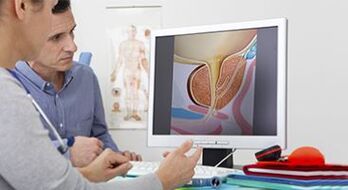Prostatitis and prostate adenoma are diseases that are often diagnosed in men. It is not surprising that the stronger sex is interested in their symptoms and other features. Let's figure out how these pathologies differ and how they are treated.

Prostatitis and prostate adenoma are diseases that are often diagnosed in men.
What is the difference between prostate adenoma and prostatitis?
In fact, there are enough differences.
They relate to the following factors:
- Time of onset of the disease.Adenoma of the prostate is usually diagnosed in men between the ages of 45-50, and prostatitis is also troubling for the younger members of the stronger sex.
- First symptoms.As a rule, with prostatitis, patients complain of discomfort (including quite pronounced pain), and with adenoma, urinary disorders.
- The reasons.Prostatitis is an inflammatory process and can be triggered by infections of the genital tract, and prostate adenoma is an overgrowth of tissue due to various factors.
- The clinical picture.Acute prostatitis is often accompanied by chills and fever, and the adenoma proceeds without signs of infection.
- The nature of the pain.Inflammation is characterized by acute pain in the groin, perineum and rectum. The tumor in the early stages may not appear in any way. Even if pain occurs, it is insignificant.
For both pathologies, sexual dysfunction is characteristic.
The reasons for the development of prostatitis

The disease develops mainly under the influence of microorganisms that enter the prostate gland from various sources. As a rule, prostatitis occurs against the background of sexually transmitted infections.
The disease develops mainly under the influence of microorganisms that enter the prostate gland from various sources.
Some specialists distinguish stagnant prostatitis into a separate group. This disease is provoked by a violation of blood circulation in the small pelvis. Against this background, inflammation occurs. The infection joins quickly enough. As a result, congestive prostatitis becomes chronic.
Symptoms of the disease
Prostatitis can occur in two forms: acute and chronic.

Not in all cases, acute prostatitis occurs with pronounced symptoms. Some men report only general malaise, mild pain and temporary weakening of sexual function.
The following symptoms are characteristic of the acute form:
- pain in the perineum;
- a feeling of aches under the scrotum;
- increased body temperature;
- pain during the act of defecation;
- increased urination;
- frequent painful urge to urinate;
- erectile dysfunction.
Also, patients complain of purulent and mucous discharge from the urethra, shooting pains in the perineum and groin, overexcitation, painful ejaculation.
Important! Not in all cases, acute prostatitis occurs with pronounced symptoms. Some men report only general malaise, mild pain and temporary weakening of sexual function. These symptoms are of a sluggish form of prostatitis and resemble prostate adenoma, which can lead to errors in diagnosis.
Chronic pathology is characterized by 3 main groups of signs:
- Painful.Men complain of soreness in the rectum and lower back, sensation of lumbago, tingling and "goose bumps" in the groin, thighs, perineum and back. Against this background, the patient may become nervous. Also, men note bouts of sweating and chills.
- Dysfunction of urination.Men complain of a sluggish stream of urine, difficulty trying to empty the bladder, and frequent urge to go to the toilet.
- Disorder of sexual function.Patients note a decrease in libido, lack of ejaculation or its premature, difficulty with a full erection. Often against the background of prostatitis, infertility occurs.

The pelvic nerves are often involved in the pathological process. As a result, additional symptoms are added to the main symptoms of prostatitis. They consist of hot flashes and an increase in temperature in the evenings, tachycardia, as well as mood swings and problems concentrating. Some men complain of fatigue and sleepiness during the day, suspiciousness, a feeling of a lump in the throat, increased saliva production, weight gain (without changes in diet and physical activity).
The cause of benign proliferation of gland tissues is a change in testosterone metabolism in cells.
Reasons for the development of prostate adenoma
The cause of benign proliferation of gland tissues is a change in testosterone metabolism in cells. This process is inevitable and begins in men at about 40–45 years of age. Therefore, each representative of the stronger sex encounters signs of pathology to one degree or another. Usually, a benign tumor does not have pronounced symptoms at the first stage, but is diagnosed as early as 2 or 3.
Symptoms of the proliferation of gland tissues
The difference between prostatitis and prostate adenoma lies in the main symptom. With a benign tumor, urination disorders always come to the fore.

The difference between prostatitis and prostate adenoma lies in the main symptom. With a benign tumor, urination disorders always come to the fore.
They are usually divided into 2 groups:
- Irritative signs.Patients complain of increased urge to urinate, the need for regular nighttime emptying of the bladder, urinary incontinence.
- Obstructive signs.They are a consequence of the narrowing of the urethra with the growth of the gland. They manifest themselves in the need for straining when urinating, a weak stream of urine, its dripping drops.
As the disease progresses, the kidneys, ureters and pelvis are involved in the pathological process. This leads to an increase in blood pressure, back pain, constant thirst, itching, weakness, and a general deterioration in well-being. Patients develop pathologies of the cardiovascular system. Also, men complain of suppression of sexual function. Infectious complications of prostate adenoma are also detected. In some cases, stones form in the bladder. Signs of varicose veins (if any) may also worsen.
Principles of treatment of prostatitis and prostate adenoma
Disease therapy is carried out using various groups of drugs.
Treatment for prostatitis is aimed at:
- suppression of the inflammatory process;
- stopping the active reproduction of bacteria;
- improving the outflow of lymph and blood circulation in the veins of the small pelvis;
- prevention of chronicity of the pathological process.
For these purposes, patients are prescribed anti-inflammatory and antibacterial drugs, as well as venotonics and blood thinners. Enzyme agents and stimulants of the immune response are recommended.
Treatment for prostate adenoma is aimed at:
- volume reduction;
- restoration of normal urination.
To solve these problems, patients are prescribed alpha-blockers, 5-alpha-reductase inhibitors, phytopreparations and other agents.

And with prostatitis, and with prostate adenoma, restoration of potency may be required. For this, combined preparations are prescribed based on herbal ingredients and other components. The funds can be used simultaneously with the treatment of major pathologies. When taken correctly, they are not harmful to the body.
Important! Any drugs are prescribed exclusively by a doctor. Self-medication is strictly prohibited. It can change the clinical picture and lead to difficulties in diagnosis. In addition, self-prescribing medications can lead to a deterioration in well-being. You should also not cancel the drugs yourself!
In some cases, for diseases, surgical treatment is performed. It is prescribed when conservative therapy is ineffective or inappropriate for one reason or another.
As a rule, surgical interventions are relevant at 2–3 stages of prostate adenoma.
The main operations include:
- TUR (transurethral resection);
- laser treatment;
- laparoscopy;
- interventions using the da Vinci robot.
All operations are minimally invasive. They reduce damage to healthy tissue and provide a short rehabilitation period.

The technique of the operation is chosen by the doctor based on the available indications, concomitant diseases of the patient and his individual characteristics.
Successful treatment of prostate adenoma and prostatitis includes:
- Quitting bad habits (smoking and alcohol abuse);
- Exclusion of animal fats, as well as canned foods, smoked and fried foods;
- Restriction in the diet of simple carbohydrates;
- The intake of a sufficient amount of fluid in the body (at least 2 liters of water);
- Regular visits to your doctor. You should contact him even in the absence of signs of pathologies. This will allow timely identification of all changes and prevent the development of complications.
Benefits of going to the clinic
- Experienced doctors.Our specialists have long been involved in the diagnosis and therapy of prostate pathologies. They have the necessary knowledge and skills to carry out a wide range of manipulations.
- Possibilities for fast diagnostics.Our specialists use expert class equipment. It allows you to make a diagnosis on the day of treatment.
- An individual approach to therapy.Treatment of prostatitis and prostate adenoma is provided taking into account the type and stage of the disease, the characteristics of the patient, as well as the comorbidities he has.
- Conservative therapy using modern techniques.
- Modern methods of surgical treatment.Surgical interventions are performed using a laser and a da Vinci robot. Laparoscopic operations and TUR (transurethral resection) are performed. This allows you to reduce the risks of interventions and the duration of the rehabilitation period.
- The comfort of visiting clinics.They are located near the metro. In addition, we have taken care of the absence of queues and are ready to receive patients at a convenient time for them.
























